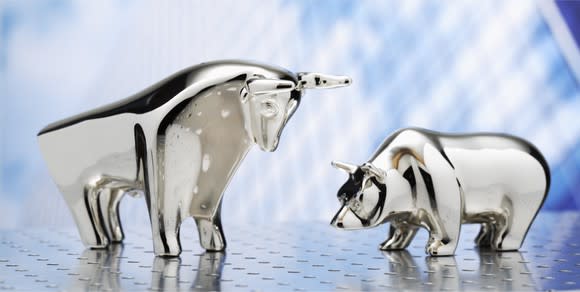Better Buy: NIKE, Inc. (NKE) vs. Adidas (ADDYY)
Nike (NYSE: NKE) is the king of the athletic footwear and apparel market, but its top rival Adidas (NASDAQOTH: ADDYY) staged a remarkable comeback in recent years. Over the past three years, Adidas shares rallied nearly 200%, while Nike shares advanced just 32%.
In 2017, Adidas' 27% gain outpaced Nike's 23% gain, but both stocks outperformed the Dow Jones US Apparel Retailer Index's 5% growth. But can Adidas keep outperforming Nike this year? Let's take a closer look at both companies to decide.

Image source: Getty Images.
The differences between Nike and Adidas
Nike generates most of its revenue from its namesake brand, with a much smaller percentage coming from its Converse brand. Adidas generates most of its revenue from its namesake brand, with a smaller percentage coming from its smaller Reebok brand.
61% of Nike's revenue came from footwear sales last year, with the remainder coming from sales of apparel, accessories, and licensed brands. 53% of Adidas' revenue came from footwear sales, with the rest coming from apparel and sports equipment.
Nike's higher exposure to the footwear market matters, because it's generally a lower-margin industry than apparel or sports equipment. Nike's gross margin fell 160 basis points to 44.6% last year, while Adidas' gross margin expanded 30 basis points to 48.6%.

Image source: Adidas.
Nike generated $34.4 billion in sales last year, while Adidas generated €19.3 billion ($23 billion) in sales. 44% of Nike's sales came from North America during the year, compared to just 18% of Adidas' sales.
Those figures also matter because the North American athletic footwear and apparel market has been a very tough one due to intense competition and the bankruptcy of major retailers like Sports Authority. However, Adidas posted 30% sales growth in North America last year, while Nike's revenues rose just 3%.
China is a major growth market for both companies. Nike's Greater China revenues rose 12% annually and accounted for 12% of its top line last year. Adidas' Chinese revenues rose 22% last year and accounted for 16% of its top line.
How fast are Nike and Adidas growing?
Last year, Nike's revenue rose 6%, as its earnings -- lifted by buybacks -- rose 16%. For the current fiscal year, which ends on May 31, analysts expect its revenue to rise 4%, but its earnings to fall 9% on declining margins and its weakness in North America.
Therefore, it's highly unlikely that Nike will hit its target of $50 billion in sales by 2020, which would require high double-digit sales growth over the next three years.
Adidas' revenue rose 14% last year, and its earnings from continuing operations jumped 41%. For the current year, which ended on Dec. 31, Adidas expects to report 18% sales growth and 27% earnings growth.

Image source: Getty Images.
Adidas is reaping the benefits of the five-year turnaround plan it initiated in mid-2015. That ambitious plan called for the faster production and rotation of its products, expansions into major urban markets, higher e-commerce investments, and deeper engagement campaigns with customers, retailers, and partners.
Instead of relying heavily on highly paid athlete endorsers like Nike, Adidas worked with celebrities like Kanye West, who oversaw the creation of its best-selling Yeezy shoes. Its "Boost Technology" soles also made its shoes tremendously popular among runners.
Nike is responding with new product categories like its React running shoes, bouncy VaporMax shoes, and ZoomX soles to counter Adidas' Boost. It's also executing its "Triple Double Strategy" to improve its innovation, production speed and direct connections to consumers on multiple fronts.
But Nike is still playing defense against Adidas as it tries to reduce its dependence on the sluggish North American market and expand its product portfolio.
The valuations and dividends
Nike trades at 28 times earnings, which merely matches the industry average of footwear and accessories makers. Adidas is slightly cheaper, with a trailing P/E of 27. But looking ahead, Nike's forward P/E of 28 is much higher than Adidas' forward P/E of 22.
However, Nike's forward dividend yield of 1.2% beats Adidas' 1% yield. Nike spent 31% of its earnings on that dividend over the past 12 months, and Adidas spent 30% -- which gives both companies ample room for future hikes.
The winner: Adidas
Nike is a low-risk stock, but Adidas' better diversified business, smart turnaround moves, stronger growth, and lower valuations make it the better investment for 2018.
More From The Motley Fool
Leo Sun has no position in any of the stocks mentioned. The Motley Fool owns shares of and recommends Nike. The Motley Fool has a disclosure policy.

 Yahoo Finance
Yahoo Finance 